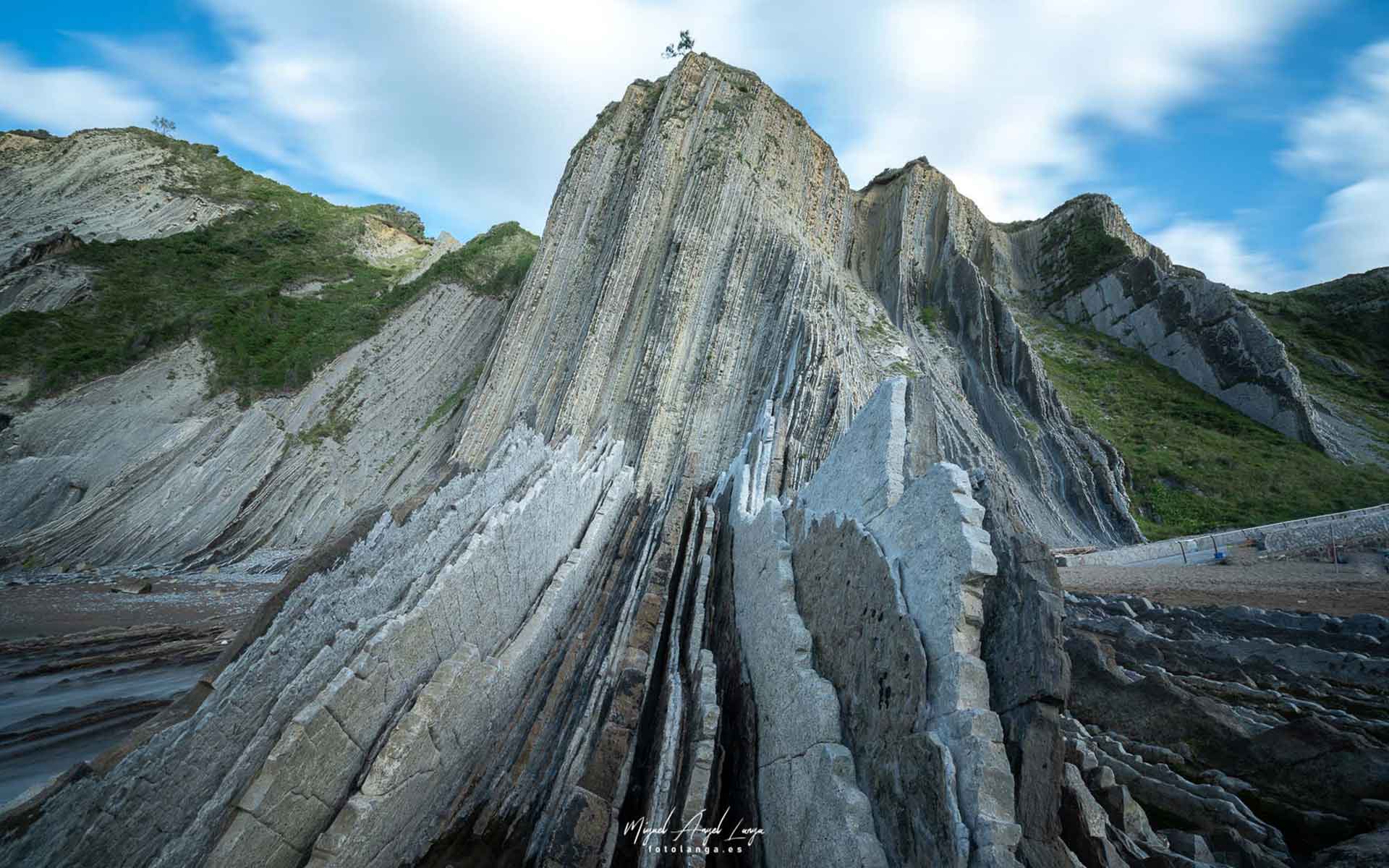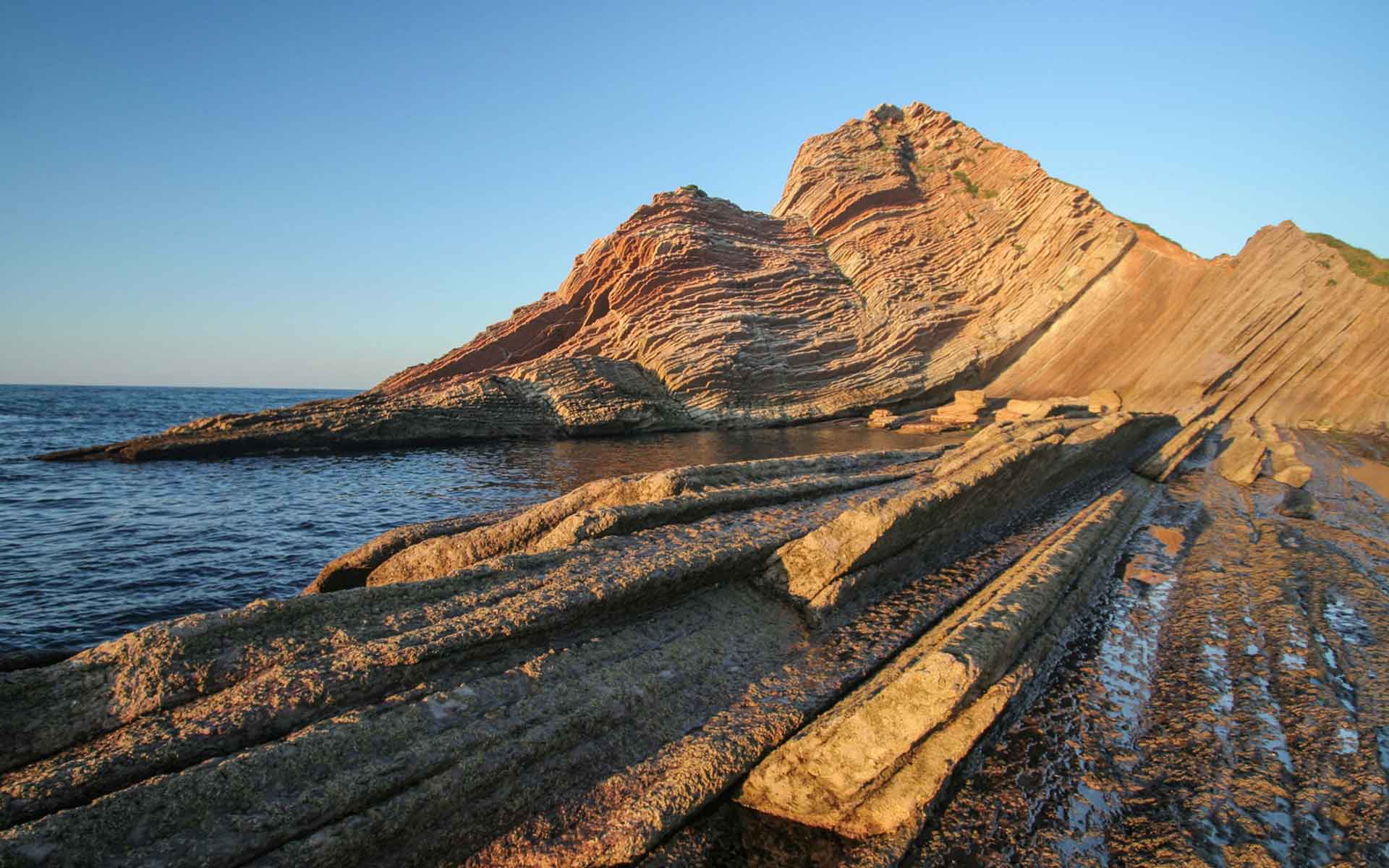
Eocene turbiditic system in Zumaia, which was the cover of the classic book “Atlas and Glossary of Primary Sedimentary Structures” (F.J Pettijhon and P.E Potter, Springer –Verlag 1964). (Photo: M. A. Langa).
Geological Period
Cretaceous- Paleogene
Main geological interest
Stratigraphy and sedimentology
Paleontology
Location
Zumaia, Basque Coast Geopark, Spain.
43°17’59.0″N, 2°15’41.0″W
Eocene turbiditic system in Zumaia, which was the cover of the classic book “Atlas and Glossary of Primary Sedimentary Structures” (F.J Pettijhon and P.E Potter, Springer –Verlag 1964). (Photo: M. A. Langa).
One of the best exposed, most continuous and highly studied outcrops of deep marine sediments in the world.
Zumaia section provides critical information about climate and biosphere evolution through critical intervals of geological time. The integrated bio-, magneto- and cyclostratigraphic records helped to reconstruct the K/Pg mass extinction (Gilabert V. et al., 2021) and the impact of the PETM global warming in the oceans and the subsequent recovery, and to define the GSSPs for the bases of the Selandian and Thanetian stages. The concentration of these major events marking key chronostratigraphic boundaries in a continuous section makes Zumaia one of the most studied and referenced stratigraphic outcrops of the World. Zumaia is also a key location for study of deep marine trace fossils.
- Geological description
The Cretaceous – Paleogene stratigraphic section of Zumaia is magnificently and continuously exposed along 10 km of beautiful sea cliffs on the Basque coast. This deep marine succession, brought to the surface during the Pyrenean orogeny, comprises hemipelagic marl/limestone alternations and intercalated turbidites. One of the early models of deep-water submarine fans were partly based on Eocene deposits from Zumaia (Kruit C. et al., 1972). The two major events bracketing the Paleocene Epoch, i.e. the mass extinction at the Cretaceous/ Paleogene (K/Pg) boundary and the global warming across the Paleocene Eocene Thermal Maximum (PETM) had dramatic environmental and evolutionary consequences and are exceptionally well recorded at Zumaia (Ward PD, et al., 1991) Extensive analyses of greatly preserved foraminifera and calcareous nannofossils have helped to refine the biostratigraphic scales and to infer the paleoenvironmental consequences of these global events (Alegret et al., 2009). Additionally, detailed magneto and cyclostratigraphic studies made Zumaia a key reference section for the Maastrichtian and Paleocene astrochronological timescale (Dinnares-Turell J. et al., 2014). Not surprisingly, Zumaia was unanimously selected to place the GSSPs for the bases of the Selandian and Thanetian stages, turning into one of the very few outcrops containing two IUGS Global stratotypes in the World (Schmitz et al., 1972).
- Scientific research and tradition
Zumaia has long attracted Geologists’ interest. Since 1946 more than 120 research articles appeared in refereed journals and more than 10 PhD Theses are partly, or entirely, based on the section. Photos of Zumaia have been used as the front cover of many publications, including Pettijonh and Potter’s, 1964, Atlas of Sedimentary Structures.
- Reference
Alegret, L. et al. (2009) ‘The Paleocene–Eocene thermal maximum: new data on microfossil turnover at the Zumaia section, Spain’, PALAIOS, 24(5), pp. 318–328. Available at: https://doi.org/10.2110/palo.2008.p08-057r.
Dinarès-Turell, J. et al. (2014) ‘Astronomical calibration of the Danian stage (Early Paleocene) revisited: Settling chronologies of sedimentary records across the Atlantic and Pacific Oceans’, Earth and Planetary Science Letters, 405, pp. 119–131. Available at: https://doi.org/10.1016/j.epsl.2014.08.027.
Gilabert, V. et al. (2022) ‘Contribution of orbital forcing and Deccan volcanism to global climatic and biotic changes across the Cretaceous-Paleogene boundary at Zumaia, Spain’, Geology, 50(1), pp. 21–25. Available at: https://doi.org/10.1130/G49214.1.
Kruit, C., Brouwer, J. and Ealey, P. (1972) ‘A Deep-water Sand Fan in the Eocene Bay of Biscay’, Nature Physical Science, 240(99), pp. 59–61. Available at: https://doi.org/10.1038/physci240059a0.
Schmitz, B. et al. (2011) ‘The Global Stratotype Sections and Points for the bases of the Selandian (Middle Paleocene) and Thanetian (Upper Paleocene) stages at Zumaia, Spain’, Episodes, 34(4), pp. 220–243.
Ward, P.D. et al. (1991) ‘Ammonite and inoceramid bivalve extinction patterns in Cretaceous/Tertiary boundary sections of the Biscay region (southwestern France, northern Spain)’, Geology, 19(12), pp. 1181–1184. Available at: https://doi.org/10.1130/0091-7613(1991)019<1181:AAIBEP>2.3.CO;2.
- Author(s)
Victoriano Pujalte
University of the Basque Country
Laia Alegret
University of Zaragoza on behalf of the ISPS- International Subcommission on Paleogene Stratigraph
Asier Hilario
Scientific director of the Basque Coast UNESCO Global Geopark


